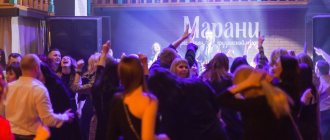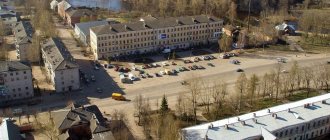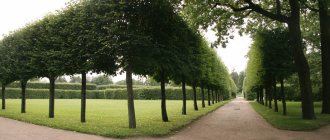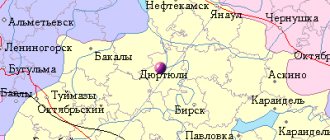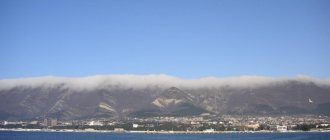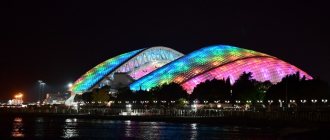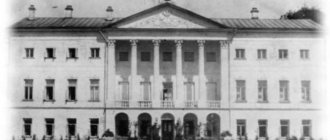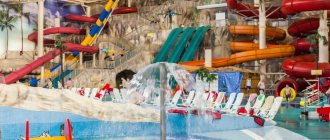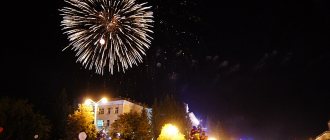Kurgan is a Russian city located on the banks of the Tobol River. The exact date of its foundation is still unknown - scientists have not come to a consensus on this matter. The official version is this: Kurgan grew out of a small peasant settlement founded in 1679 by an ordinary peasant Timofey Nevezhin, who was the first to build himself a home on the banks of the Tobol River among the ancient burial mounds. The settlement grew and developed, and in 1782, through the efforts of Catherine the Great, it was given the status of a city.
Modern Kurgan combines the beauty of a provincial town and a large administrative center of the Kurgan region. The main impetus for rapid development was the Trans-Siberian Railway laid through the city. Now this city is a large industrial center with a developed medical and educational structure. It is in Kurgan that the world-famous center of Ilizarov, the creator of an apparatus for fusion of bones, is located.
For ease of route planning, we have marked all the mentioned attractions on the city map:
Monument to customs officer Pavel Vereshchagin
The most famous monument of Kurgan. The bust of the hero of the film “White Sun of the Desert” is located near the Kurgan customs building.
The monument was erected on the initiative of the head of customs in 2007. The team supported the manager’s initiative, and the required amount was collected very quickly.
Address: st. Burova-Petrova, 132.
Monument Zero Kilometer
Many cities around the world have a similar monument. Residents of Kurgan decided: a monument to the Zero Kilometer should appear in their hometown. A bronze figure of a postman was installed in 2012 at the main post office. Now all roads are measured from this place.
The author of the project is local artist Boris Orekhov. Tourists often take pictures next to the postman.
Address: st. Gogol.
Monument to Parents
Another project implemented by the Mama Foundation with the support of the residents and authorities of Kurgan. A couple expecting a baby - this is what a monument to parents looks like. Young people are dancing. The beautiful bronze sculptural composition looks touching and tender.
Address: st. Gogol.
There are several interesting exhibitions in Kurgan. One of the museums attracts the attention of all tourists.
Kurgan Aviation Museum
This exposition is the only one in the Urals and Siberia. Aircraft of various brands are located in an open area near the airport. Visitors to the unusual museum will be able to see airplanes and helicopters from different production periods.
Address: st. Gagarina, 41.
There are places in Kurgan associated with the names of the Decembrists. Tourists will be interested in the exhibition of the house-museum of V. K. Kuchelbecker. The museum, which contains exhibits telling about the life of the Decembrist poet, is the only one in Russia. The exhibition is located on the street. Kuibysheva, 19.
Temples and cathedrals
Alexander Nevsky Cathedral
Address: Volodarskogo street, 32 Phone: , Website: https://www.kurganvera.ru Opening hours: 9:00 – 17:00 Mon-Sun
The main Orthodox church of the Kurgan region. A real architectural monument of the 19th century. The cathedral was built at the expense of Archbishop Agafangel of Tobolsk and Siberia, local merchants and parishioners.
The first half of the money was collected in just half an hour. When it became clear that there was not enough, merchant Smolin, in whose house the fundraiser was taking place, donated an amount equal to what had already been collected for the construction of the temple.
For the construction of the cathedral, the highest place in Kurgan was chosen and consecrated, located in the middle of the old, inactive cemetery at that time.
During Soviet times, the temple did not function; its premises housed warehouses, a school and a planetarium. It was only in 1989 that the cathedral was returned to the parishioners and services began to be held there again.
Temple in honor of the Port Arthur Icon of Our Lady Solemnity of the Blessed Virgin Mary
Address: Yastrzhembsky street, 41A/1 Phone: Website: https://www.port-artur-hram.ru Opening hours: 9:00 – 17:00 Mon-Sun
The temple is the first founded and erected after the revolution in Kurgan. It was built in 2011, and in 2013 one of the parishioners donated an icon of the Mother of God to the temple. This is the only icon where the Mother of God is depicted as a protective warrior.
According to legend, the image of the Mother of God appeared to one of the sailors and ordered her face to be transferred to the icon. She predicted an imminent war, promised her protection and blessing if the painted icon was transferred to the Port Arthur Temple. After some time, the Japanese attacked the Russian fleet, and this event left no doubt in the sailor’s words.
The main admirers of the icon of the Triumph of the Blessed Virgin Mary are still sailors and military personnel. And the temple itself is located on the territory of a defense enterprise.
Next to the church there is a small exhibition of military equipment.
Holy Spirit Church
Address: p.s.t. Smolino, Maly Lane, 12 Phone: Website: https://www.kurgan.pro/okn/n166 Opening hours: 7:00 - 17:00 Mon-Sun How to get there: from the railway station and bus station, bus 339 to the stop "Church"
The Church of the Holy Spirit was built in 1901, but at that time it was located not in Smolino, but in the village of Ryabkovo. After about 30 years, the temple was closed, and for a long time its premises were used as barns for storing grain. Later a club was opened here, and after that a primary school.
Only in 1956 the church premises were returned to the parishioners again. In 1963, in connection with the reconstruction of the city of Kurgan, an order was received to demolish the church. Through joint efforts we managed to avoid demolition and achieve the transfer of the church to Smolino.
The Temple of the Holy Spirit is the second most important after the Alexander Nevsky Cathedral; it is very popular for baptismal rites.
The temple contains the relics of the Stavropol and Caucasian bishop St. Ignatius.
Decembrists Museum
In 1975, an exhibition dedicated to the activities of the Decembrists opened in the city. The museum is located in the house where Colonel M.M. Naryshkin lived since 1832.
Letters have been preserved, thanks to which it was possible to restore the exact interiors of all rooms and the internal layout. The façade looks the same as it did in the 19th century. In the museum, visitors will be able to feel the breath of past years and see hundreds of interesting exhibits.
Address: st. Klimova, 80.
Parks
Central Park of Culture and Leisure
Address: Central Park of Culture and Culture, 4 Telephone:
The Central Kurgan Park is located in the heart of the city in a picturesque green landscape. There are many fountains and sculptures, an amusement park, and all conditions for sports.
The Children's Kurgan Railway runs through the entire territory of the park. Platforms, railway tracks, trains - everything here is real, only several times smaller. Children can walk around the station, buy a ticket and ride the train, and study in detail the structure of the railway.
The Central Park of Culture and Recreation has been the main place for celebrating the city day for many years.
Cultural-historical complex “Tsarevo Settlement Park”
Address: Constitution Avenue, 32A Phone: Website: https://www.cbs-kurgan.com/carevo_gorodishe/ Opening hours: 9:00 – 19:00 Mon-Fri, 10:00 – 18:00 Sat, 11:00 – 16:00 Sun Cost: 15 – 80 rub.
This place represents the recreated buildings of the Tsarevo Settlement village. This is exactly the name the city had before Catherine the Great called it Kurgan. The cultural and historical complex allows you to imagine exactly what Kurgan looked like in the 17th century.
Art Museum
Museum workers quite rightly believe that the collection collected within the walls of the museum is unique. There are no similar exhibitions in the Kurgan region, numbering thousands of works by contemporary artists from different regions of Russia.
Visitors will see paintings by N. Dormidontov, O. Sokolova, A. Deineka, G. Shegal and many other authors. The museum often hosts creative meetings and exhibitions dedicated to memorable dates in the history of Kurgan and the region.
Address: st. Maxim Gorky, 129.
Kurgan Museum of Local Lore
The museum's exposition is one of the richest in the vastness of Siberia and the Urals. More than 200 thousand valuable exhibits cover the period from the primitive system to the present.
Thematic exhibitions are organized in the halls of the museum, which contain archaeological and paleontological finds, ancient manuscripts, silver and metal jewelry, ancient weapons, household items, photographs and archival documents.
You can spend the whole day in the halls of the museum. Come early. The museum is open from 9 a.m. to 5 p.m. Monday is a day off.
Address: st. Pushkina, 137.
Kurgan region: TOP 3 places to go right away
The visiting card of the Kurgan region is health resorts and mysterious ancient monuments. We have placed them in the “Main Attractions” section.
Bear Lake
- Coordinates on the map: 55.199537, 67.997895.
Medvezhye is a salt lake in the Petukhovsky district near the border with Kazakhstan and one of the best resorts in the region. The pond is shallow, so children can swim in it safely. The maximum depth does not exceed 1.2 meters.
The waters are so saturated with salt that they easily float even large adults. In terms of its characteristics, the reservoir is comparable to the Dead Sea. In the middle of the lake, six islands protrude from the water.
In summer, the pond is filled with salted brine shrimp - tiny crustaceans that turn the water brown and secrete a special enzyme that calms the nervous system.
Artemia are the only creatures capable of living in such an environment; neither fish nor algae can withstand such salty water. Silt has healing properties and is used in the treatment of many diseases. A health resort has been operating on the northern shore for many years.
Shadrinsky mineral waters
- Address: Shadrinsky district, Verkhnyaya Polevaya village, Sovkhoznaya street, 11.
In the vicinity of the city of Shadrinsk there are several mineral springs, famous for their bottled water “Shadrinskaya”. Geologists discovered the priceless deposit in 1970. Scientists and workers were looking for ordinary fresh water to supply the city, but accidentally discovered a real natural treasure.
In 1984, Shadri residents began bottling water. One of the wells was equipped for the city food processing plant, the second for the Zhemchuzhina Zauralya sanatorium.
Over the course of several years, specialists drilled about 30 wells. Shadrinskaya mineral water, which contains more than 20 useful substances, is compared with Borjomi and Essentuki.
The village of Verkhnyaya Polevaya also has a hot mineral spring. The temperature there stays at 33°C all year round. Water is supplied to swimming pools with hydromassage units.
Savin Sanctuary
- GPS coordinates: 55.698253, 65.644588.
Near the village of Buzan, on a small hill lies the main archaeological pride of the Kurgan region. The unusual ruins are the remains of an observatory sanctuary, in which ancient people performed religious rituals and observed the heavenly bodies. In the spring, during high water, the river floods at the foot of the hill, perhaps that is why the area is called Savin in Ugric, which translated into Russian means “hill among the swamps.”
The archeological monument was opened in 1982 by local resident Vasily Babushkin. Vasily Pavlovich collected several ancient artifacts and donated them to the local history museum. Experts became interested in the finds, conducted a series of excavations near the village and discovered two adjacent circles that looked like a huge figure eight.
Nearby they found more than a hundred holes left from pillars and three human graves. Archaeologists also found traces of fireplaces and pits with sacrifices, which contained fragments of ceramics, items made from various materials and animal bones. Scientists managed to collect more than 7,000 objects.
The sanctuary was built in the Eneolithic era, that is, more than 4000 years ago, the structure is 1000 years older than the famous Arkaim. The observatory was nicknamed “Kurgan Stonehenge”, while the Russian landmark appeared much earlier than the British one. In the vicinity there are three more archaeological monuments: Savin-2, the Slobodchiki-1 sanctuary and the Okhotino-1 settlement.
City History Museum
Visit the merchant mansion that belonged to the merchant of the 1st guild S.I. Berezin. This stone urban-type estate is the only one in the vast Trans-Urals that has preserved an enclosed courtyard with a central house and outbuildings.
The 19th-century estate contains documents, photographs of city streets, and personal belongings that belonged to famous citizens. Visit the museum on the street. Kuibysheva. On the same street there is the house-museum of the Decembrist V.K. Kuchelbecker.
Address: st. Kuibysheva, 59.
Mound
Video: Kurgan
Basic moments
The city received its name from prehistoric burial mounds - mounds, towering on the high bank of the Tobol River. Originating as a small settlement, the village initially served as a fortress that repelled attacks by nomads. Then the expanded provincial town became the county capital, and in the last century it turned into a large industrial center.
Kurgan's merchant past is preserved by wooden mansions, whose appearance sharply contrasts with the surrounding concrete buildings. Among the important historical attractions are ancient houses where participants in the December 1825 uprising, exiled here, found shelter in the 30s of the 19th century. In one of these estates there is the Museum of the Decembrists, which is definitely worth a visit to all guests of the city. Other museums of Kurgan are also interesting - historical, local history, and art.
There are theaters, cinemas, and exhibition centers in the city. Guests are accommodated in hotels, mainly three-star ones, as well as apartments and hostels. In Kurgan you can find quite decent restaurants, bars, and night entertainment venues.
History of Kurgan
The history of Kurgan dates back to the 17th century. The official date of its foundation is considered to be 1679, but perhaps the first settlement on the site of the city arose several decades earlier. Archival documents connect the emergence of a settlement on the steep bank of the Tobol with the name of the Tyumen peasant Timofey Nevezhin. He cut down the first hut here and, by order of the Tobolsk governor, began to attract “willing people” to the settlement.
The settlement was called Tsarev Settlement, indicating its location in the name: near the Tsarev Kurgan, the largest of the grave mounds grouped in this area. Historians attribute the appearance of burial grounds to the Bronze Age and the Early Iron Age.
Many legends were associated with the mounds. Some of them claimed that treasures were hidden underground. Enthusiasts first decided to check whether this was true in the first half of the 18th century by excavating the top of the Tsarev Kurgan. Having discovered nothing, but having destroyed the embankment cone during the work, they forgot about the failed venture at the official level. However, local tomb robbers did not give up hope of finding the treasure; they repeatedly opened the mounds and dug up layers of earth along with their contents. In the future, this significantly complicated the work of archaeologists. In the middle of the last century, thorough excavations of the Tsarev Kurgan were carried out. But the small artifacts found, which clearly did not correspond to the scale of the work, caused disappointment among scientists. Soon the mounds were completely razed, and neighborhoods were built in their place, where families of energy workers settled.
At the turn of the 17th-18th centuries, Tsarevo Settlement was moved 8.5 km downstream of the Tobol due to one of the mounds sliding into the river. A wooden fortress was built in a new place, which became part of the defensive line that protected the lands conquered by the Russians from nomads. Local residents, descendants of settlers, were always ready to take up arms. A significant part of them were white-local Cossacks, a kind of peasants liable for military service. Later the Siberian Dragoon Regiment was stationed here.
In 1738, Tsarevo Settlement began to be called Kurganskaya Sloboda. By the middle of the 18th century, the settlement was surrounded by a triple line of fortifications, and 30% of its inhabitants were service people. At that time, the fortress garrison was the largest in the entire Tobol region. In 1782, according to the decree of Catherine II, the settlement received the status of a city, the district center of the Tobolsk province and a new name - Kurgan. By that time, the fortress had already lost its defensive significance. Now local residents were mainly engaged in agriculture, cattle breeding, and trade. The population was small - about 1000 people, mostly peasants, townspeople, merchants, and retired military personnel.
Even under Peter I, the first exiles appeared in Tsarev Settlement, and in 1830, 13 Decembrist officers were sent to settle in Kurgan. Some settled here with their families. With their arrival, social and cultural life in the city revived. These active, educated people were engaged in education and charity, leaving a good memory of themselves. In the 60s, the population of Kurgan was replenished with almost a hundred exiled Poles.
In 1893, a new section of the Trans-Siberian Railway was opened, connecting Chelyabinsk and Tyumen. Trains passed through Kurgan. From that time on, the city began to develop rapidly, and local businessmen began to have foreign competitors. The Danes, for example, energetically began producing and exporting Siberian butter, meat, and sausages to Europe. Before the outbreak of the First World War, about 50 businesses operated in the city, and its population reached almost 40,000 people. Kurgan had its own gymnasiums, vocational schools, a theater, a circus, a cinema, and a photo studio.
During the Civil War, the city changed hands more than once, until Soviet power was finally established here in 1919. The industrial revival of Kurgan began a few years later. The economy also actively developed during the Great Patriotic War, when the rear city received enterprises that produced defense, engineering, and food products evacuated from the western regions of the USSR.
Military schools and an aviation school were stationed in Kurgan; military units and formations were formed, including the 32nd reserve ski regiment of the “white devils,” as the Nazis called these warriors. Military hospitals were also located here. One of them was converted into a veterans' hospital after the war. The legendary Gavriil Ilizarov worked there as a traumatologist-orthopedist. In 1950, he invented a unique compression-distraction device for healing bone fractures. The Ilizarov Center, which opened in Kurgan in 1971, is now world famous.
Geography
The mound is located in the basin of the Ishim steppe valley, located on the flat interfluve of the Tobol and Irtysh, in the southern part of the West Siberian Lowland. It is separated from Moscow by 1973 km. The shortest distance to the state border with Kazakhstan is 200 km. Historically, Kurgan developed on the left, high bank of the Tobol, where most of the urban areas are located today. The right bank is low-lying, with flooded hay meadows stretching along it.
Kurgan is divided into 9 districts and three dozen microdistricts. Some of them are just tiny and consist of 1-3 streets, others have formed around train stations. The central district of the city is located near Tobol. Its tributary, the Chernaya River, crosses the northern part of Kurgan, where the prestigious Zaozerny district was built on swampy terrain. Next to it is the Black Lake, favored by fishermen. Pike, perch, carp, and crucian carp are found here. Despite the name of the reservoirs, the water in them has a completely natural blue-blue color, although it cannot be called crystal clear.
Ecology and climate
Kurgan is built up quite chaotically, largely due to the fact that during the war years, evacuated enterprises were integrated into the urban fabric in an emergency manner. An appropriate infrastructure was created around the hastily erected factory buildings. A number of large industrial locations in Kurgan are “built” directly into residential areas. Given the wind pattern, which usually blows from the northwest in winter and from the southwest in summer, in many urban areas the level of air pollution at different times of the year often exceeds the norm. The unfavorable ecological situation is also influenced by the fact that the air masses above the Kurgan located in the basin often stagnate. It is difficult for the coniferous and birch forests spread around the city to cope with their recreational task.
The local climate is close to sharply continental. Winters here are snowy, harsh, and long – up to 5-6 months. The usual temperature for December-February is –20…–15 °C. There are also frosts of 40 degrees, usually extreme cold occurs in January. March brings with it strong gusty winds that blow with varying intensities for about two months.
Spring in Kurgan is very short. It begins in April, and in mid-May the capricious summer begins here. Until the end of August, temperature indicators can vary from week to week, varying on average from +20...+23 °C to +30...+35 °C. The highest temperature on the city streets was recorded in 1952 and was +40.5 °C. In the first half of September it is still quite warm here: +15…+20 °C. Then it gradually gets colder, and by the end of the month the thermometers fluctuate around +6...+9 °C. Winter makes itself felt in the third ten days of October, when the first frosts usually begin.
Sights of Kurgan
The sights of Kurgan are concentrated in the Central region. Its core is the city garden, Lenin, Kuibysheva, Klimova, Sovetskaya streets, where dozens of pre-revolutionary houses are located. A unique architectural symbol of the city is the fire station building with a 27-meter tower, built in the 80s of the 19th century. The fire station is still located here today. The house of the merchant Dunaev is noteworthy - an elegant wooden mansion, richly decorated with carvings. Among the panel boxes on Pushkin Street lies the house of engineer Ostapts, similar to a fairy-tale tower, with narrow high windows and a roof topped with a turret.
In Kurgan you can see houses in which exiled Decembrists from wealthy families lived. The fighters against autocracy, who did not have the means, rented small apartments and outbuildings from local residents, so their “residences” were not preserved. However, the memory of all the revolutionaries exiled to Kurgan is preserved by the Decembrist Museum on Klimov Street. It is located in a house that convicted Colonel Mikhail Naryshkin purchased from a local official and rebuilt to his taste. Contemporaries claimed that it was the most beautiful building in the city.
The Naryshkin family lived in a one-story wooden mansion in the 30s of the 19th century. An exhibition containing more than 2000 exhibits is located in 8 halls. The museum has recreated the interiors of the living room, dining room, library, rooms of the owners and their children. The furniture is interesting, made of mahogany, complemented by elegant bronze, porcelain, and silver items. The descendants of the Decembrists donated memorial items to the museum - books, portraits and personal belongings. The Naryshkin heirs replenished the museum funds with a wonderful collection of clothing of the noble class, elegant tableware, tablecloths and bed linen from Dutch linen from the century before last.
In Kurgan, it is also worth checking out the small Wilhelm Kuchelbecker Museum on Kuibyshev Street. The exiled poet, Pushkin’s friend, lived in this modest wooden house for two years. On Sovetskaya Street there is a beautifully restored house, which became shelter for Baron Andrei Rosen, his wife and children for 4 years. Today it houses a children's art school.
Not far from Kuchelbecker’s house, in a mansion built in 1868, the Kurgan History Museum is located. This building, erected in the style of Russian provincial classicism, is the only stone urban merchant estate of the 19th century preserved in the Kurgan region. Initially, the estate belonged to the merchant of the 1st guild, Semyon Berezin, and then was purchased by the city authorities to house the district treasury.
On the ground floor there is a collection of archival documents, rare photographs of the city of the late 19th – early 20th centuries, pre-revolutionary theatrical costumes and musical instruments are on display. On the second, the interiors of a merchant's house are recreated. Romance evenings are regularly held in the living room, furnished with antique furniture.
The Kurgan Regional Museum of Local Lore (Pushkin St., 137) has a large collection of historical and cultural collections. The exhibition presents archaeological finds, objects and documents related to the development of the region in the pre-revolutionary period. A large section reflects the stages of the Soviet era. One of the halls is dedicated to the nature of the Kurgan region.
An interesting exhibition of aircraft can be viewed at the branch of this museum, at the exhibition site near the local airport. There are 15 aircraft assembled here. Among them are passenger aircraft Il-14, Yak-40, An-24, combat fighters MiG-17, Su-25. The neighboring building displays military pilot uniforms, training equipment, and models of winged aircraft. There is also an exhibition dedicated to sports aviation.
While walking around Kurgan, travelers see many monuments and sculptural compositions built in Soviet times and today. In 2022, an impressive bronze monument to Timofey Nevezhin was erected on the square in front of the railway station. The five-meter figure of the founder of the Kurgan rises on a pedestal of the same height. A remarkable sculpture of a postman with a “Kilometer Zero” signpost is located in front of the main post office. It is located next to the central square of the city, named after Vladimir Lenin. The architectural ensemble of the square, reflecting the traditions of the Leningrad architectural school, was formed in the 50s of the last century. The buildings facing it are built in the Stalinist Empire style.
The main temple of the city is the red-stone Alexander Nevsky Cathedral, built at the turn of the 19th-20th centuries with donations from the Kurgan merchants. It impressively rises above the treetops of the city garden, distinguished by an elegant hipped bell tower with a clock - a rare detail on the façade of Orthodox belfries in the provinces. From the outside, the temple looks compact, although its interior is quite spacious due to the absence of columns and partitions. The interiors of the cathedral look strict and noble.
In 2015, the Epiphany Cathedral was built on Klimova Street, in the bend of Tobol. The architectural appearance of the temple is symbolic. It captures the traditions of Russian church architecture of the 17th-18th centuries - the era of the development of Trans-Ural lands by Russian pioneers and the establishment of Orthodoxy here. The temple is famous for its collection of icons created in the 17th-19th centuries.
Excursions
City travel agencies offer excursions around Kurgan. Those interested can go to the Tsarevo Gorodishche park, located 8 km from the city center. This cultural and historical complex was created in 2013 on the banks of the Tobol. In the park you will get an idea of what the settlement, the predecessor of Kurgan, looked like in the 17th century.
The buildings of the first settlers, a watchtower, and a fragment of a defensive wall have been recreated on the territory. Visitors are invited to try on old clothes, walk around the territory, watch films about Kurgan, and look into the souvenir shop where handicrafts are sold. “Tsarevo Settlement” is a popular place for photo shoots. On holidays, costumed theatrical performances with songs and dances are held here.
40 km from the city, in the wide floodplain valley of Tobol, there is a unique archaeological monument - the Savin sanctuary, which is called the Trans-Ural Stonehenge. Researchers discovered this location on the hill of the same name, surrounded by oxbow lakes. The remains of ancient structures found here date back to the 4th-3rd millennia BC. e. Scientists studying traces of prehistoric buildings indicate that Savin was not only a sanctuary where religious rituals and sacrifices were performed, but also an archaeastronomical observatory for observing the sacred luminaries - the Sun and the Moon. Today, as part of the creation of an open-air museum, a full-size reconstruction of the archaeological site has been almost completed.
The area in which Savin is located is also noteworthy. Residents of the surrounding villages have long been afraid to visit here, fearing evil spirits living among the ancient graves. Here you will be told about strange phenomena occurring on numerous surrounding lakes: oncoming waves, mournful sounds in the night, tattered fishermen’s nets, and so on. A popular theme in local legends is the machinations of mermaids. These evil creatures, according to popular belief, live in almost every body of water.
Entertainment
There is not much entertainment in Kurgan. City dwellers traditionally spend warm days outdoors. A favorite vacation spot is the Central Park of Culture and Leisure, located in the Tobol floodplain. Here guests will find sports grounds, exercise equipment, and attractions - both modern and inherited from Soviet times. A children's railway is laid around the territory. Lovers of silence stroll along the alleys framed by birch, spruce, and rowan trees.
In the very center of Kurgan there is a city garden. This small green corner is decorated with interesting sculptures. Near the Alexander Nevsky Cathedral located here there is a bridge of lovers, hung with locks and other attributes of fidelity. There are playgrounds for children in the garden and several attractions.
To the north of the city, in a pine forest, lies the popular Blue Lakes recreation area. The reservoirs are flooded quarries where sand was previously mined. All of them are connected by wide channels, with the exception of a separate round lake, on the shore of which there is a paid sandy beach. The municipal beach area stretches along the neighboring bay. Both locations are looked after: before the start of the swimming season, the bottom of the reservoirs is cleaned, the sand on the shore is renewed, and the grass in the adjacent areas is mowed.
The water in the lakes warms up quickly. Although the ice here finally disappears only at the end of April, the swimming season already begins in June. It continues until the last days of August. In winter, “Blue Lakes” attracts those who like to swim in the ice hole, and in spring and autumn – those who want to have a picnic in nature. You can get here from Kurgan by car in 20 minutes, by bus or minibus - in 40 minutes. A public transport stop is located a couple of minutes walk from the recreation area.
Back in the 20s of the last century, the massive development of skiing began in Kurgan. Today there are 4 ski centers operating here. Recently, a modern ski base was opened in the village of Uval, where conditions have been created for the training of professional athletes, and trails have been laid for amateurs. Every winter, Kurgan residents have the opportunity to ski outside the city along pre-prepared routes.
In Molodezhny Square there is the Yunost sports complex, which has a large modern ice arena for amateurs and professionals. Ice skating is accompanied here by music and lighting. Night skiing has become very popular lately. Yunost has a fitness room and a cafe.
In the shopping and entertainment center Hiper city (Koli Myagotina St., parents with children will find the Zamania family adventure park. On 2800 m² there is a trampoline center, a climbing wall, playgrounds, and separate rooms for parties. Children are entertained by animators. You can have a snack in a family cafe with European and Russian cuisine.Another popular vacation spot among city residents is the Pushkinsky shopping center (Pushkinskaya St., 25).There is a 3D cinema, a cinema bar, and a playground for children.
parents with children will find the Zamania family adventure park. On 2800 m² there is a trampoline center, a climbing wall, playgrounds, and separate rooms for parties. Children are entertained by animators. You can have a snack in a family cafe with European and Russian cuisine.Another popular vacation spot among city residents is the Pushkinsky shopping center (Pushkinskaya St., 25).There is a 3D cinema, a cinema bar, and a playground for children.
In the evening you can go to the cultural center (Koli Myagotina St., 100). Fans of nightlife will not find a better place in Kurgan! Visitors can enjoy a disco hall, bowling alley, billiards, hookah bar, and restaurant. The establishment is open from 21:00 to 06:00.
Souvenirs
Souvenir shops in Kurgan mainly feature products made from wicker and birch bark. A variety of products are traditionally made from this flexible material in the city - from elegant chests, caskets, cups, flasks to furniture.
A popular souvenir is textile dolls, which are soft amulets with barely drawn facial features. The pottery is also very nice, and there are unusual ceramic items: horseshoes for luck, coins. Specialty stores sell carpets woven in one or two colors, according to local traditions.
As edible gifts, delicious dried peled (this fish is called “cheese”) and a variety of meat products are brought from Kurgan. Local beer "Gampl" is popular.
Cafes and restaurants
Culinary establishments in Kurgan are represented by restaurants, pizzerias, pubs, and sushi bars. Russian, European, and Caucasian cuisine predominates in restaurants. The average cost of a dinner, including an appetizer, main course and a glass of wine, will be 1000-1200 rubles per person. In a pub, you will spend 800-900 rubles for a meal accompanied by a couple of glasses of beer.
Delicious lunches await guests at the Well-Fed Barin, one of the most popular restaurants in Kurgan. The establishment is located in the city center, in the building of the entertainment and hotel complex "Academy". In addition to the large hall, there is a stylishly decorated Old Russian Hall, an Antique Salon, a Knight's Hall, and an open summer veranda. Inexpensive breakfasts are served from 07:00 to 10:00; for a business lunch (290 rubles) come between 12:00 and 16:00. You can have a modest snack here for 500-600 rubles per person, but the cost of the main dishes for a banquet is 700-900 rubles.
The restaurants “Gosti” (6 Pichugina St.), Dolce Familia (Sovetskaya St., 123), and “Yesenin” (K. Marx St., 58-B) offer good cuisine and a comfortable atmosphere. Fans of Japanese gastronomy can go to the Yamato restaurant, which is located near the Alexander Nevsky Cathedral. In the stylish tavern “Santa Fe” (Sovetskaya St., 73), you can have a bite to eat Mexican cuisine.
Fast food in Kurgan is represented mainly by pancakes. In local pancake shops they are offered, on average, for 150-200 rubles.
Where to stay
The hospitality industry in Kurgan is well developed. There are 13 hotels built in the city, as well as dozens of mini-hotels and private apartments.
In the building of the former cultural center of the Stalin era, the Academy Hotel is located (Myagotina St., 100). The façade is distinguished by an elegant neoclassical portico, and the high vestibule is decorated with stucco decoration. There are 48 spacious rooms to choose from, from budget to luxury. There is a restaurant serving original cuisine on the ground floor. Guests can enjoy the fitness center with jacuzzi. Daily accommodation will cost 2662-3270 rubles. "Academy" is located in the center, the main attractions of Kurgan, shops, cafes and restaurants are within walking distance.
Hotel "Cosmos" is located on Gagarina Street, 41-B. The rooms have air conditioning and refrigerators. Suites have minibars. Guests have access to a restaurant and a sauna. The hotel building is located 3 km from the airport. Next door is an exhibition site for aviation equipment from previous years. It is a convenient place to stay for travelers planning an early flight, but it is a bit far from the city center. The price range for accommodation is 4329-7139 rubles. Breakfast is included (buffet).
On the western outskirts of the city, near the Oryol Reservoir, the Kurgan Hotel was built (52 Constitution Avenue). Here you can rent inexpensive rooms, from 880 rubles per day. Nearby there is a wonderful place for walking - the Tsarevo Settlement Park.
Those traveling with a small group will find it convenient to stay in an apartment, paying 1200-1500 rubles. You can spend the night in a hostel for 500 rubles.
Booking.com
Transport
Urban transport in Kurgan is represented by buses and minibuses, and there is a taxi service. The trolleybus lines that recently existed on the streets have been eliminated.
All the city's attractions can be explored on foot or by renting a bicycle. The local company offers bike rentals.
How to get there
Kurgan is connected by regular flights to Moscow. Planes depart from Vnukovo Airport, the flight lasts 3 hours. Kurgan Airport is located 6 km northeast of the city center at the address: st. Gagarina, 41. From here buses No. 5, 73, 325, 378, 403 run to the central blocks.
Trains Moscow – Kurgan depart from the platforms of the Kursk and Kazan stations of the capital. Travel time – 34 hours 46 minutes. In addition, trains traveling on the route Petropavlovsk - Moscow and Petropavlovsk - St. Petersburg stop at the city railway station.
In the schedule of the Kurgan bus station (Sobanina Square, 1), you will find intercity flights to Yekaterinburg, Tyumen, Ufa, Chelyabinsk, Magnitogorsk, Perm and other cities.
Fire Tower
One of the oldest symbols of the Kurgan. The city government in 1877 decided to build the structure that the city needed. Four years later, the stone fire building and tower were put into operation.
Today the fire complex of the 19th century is an architectural monument. A firefighter dummy is installed on the tower.
Address: st. Kuibysheva, 62.
How to get there
There is an airport of the same name in Kurgan, which accepts flights from only one city - Moscow. There is one flight per day from the capital, the flight lasts almost three hours. Ticket price: from 8,000 rubles.
By train you can get to Kurgan from Moscow, Yekaterinburg, St. Petersburg, Novosibirsk, Belgorod, Petropavlovsk, Irkutsk, Omsk, Chelyabinsk, etc. The trip from Moscow will last 33–35 hours. Ticket price: from 1900 rubles. You can get from St. Petersburg to Kurgan by train in 46–47 hours. Ticket prices start from 4,000 rubles.
The station building was built at the end of the 19th century, but after numerous reconstructions it bears little resemblance to the construction of those years
Bus routes to Kurgan depart from Yekaterinburg, Nizhnevartovsk, Nizhny Tagil, Perm, Surgut, Tobolsk, Tyumen, Khanty-Mansiysk, Chelyabinsk and Shadrinsk. You can only get from Moscow and St. Petersburg by private car; buses do not go to Kurgan. A trip from St. Petersburg by personal vehicle will take about 30 hours, not including sleep. You will have to overcome 2700 kilometers. From the capital to Kurgan the distance is 2000 kilometers, which can be covered in 22 hours. You should travel along the M7, M5 and P254 highways.
